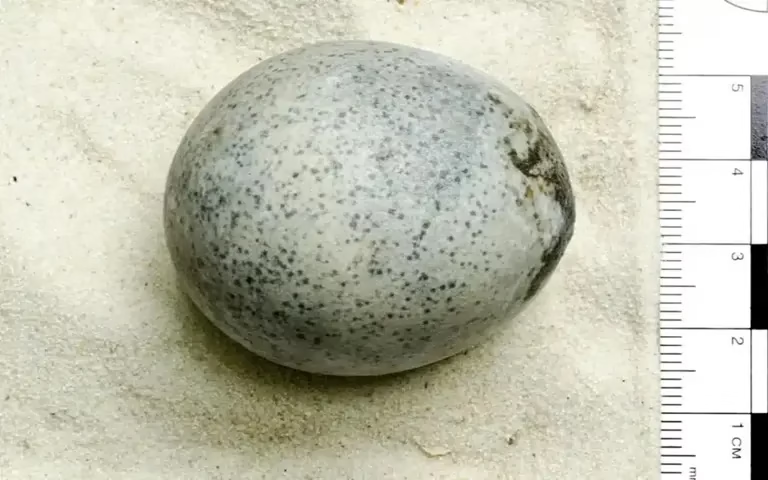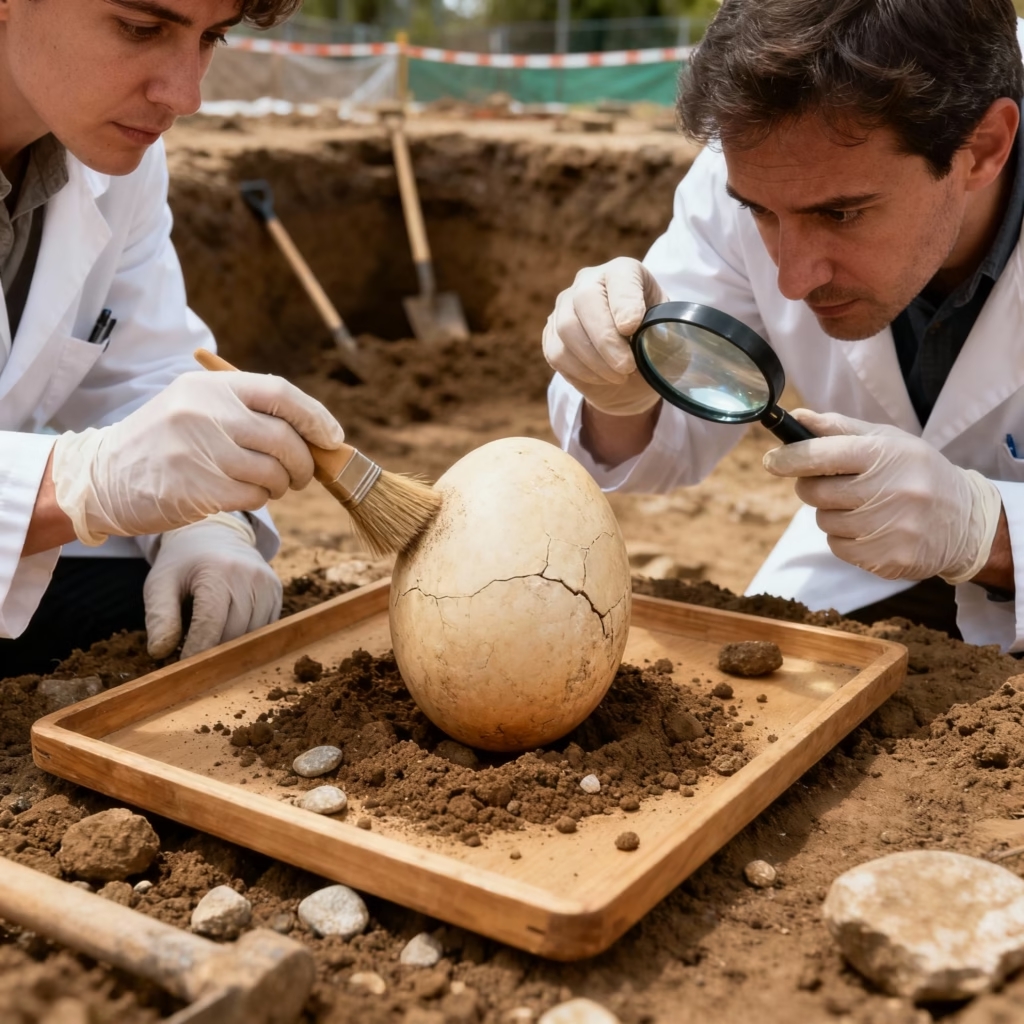Scientists Discover a 1,700-Year-Old Egg With Liquid Still Inside – A Historic Archaeological Breakthrough in England
A team of archaeologists from Oxford Archaeology recently uncovered one of the most extraordinary and delicate finds ever recorded in the United Kingdom — a 1,700-year-old Roman egg that astonishingly remained intact with its original liquid content preserved within. Unearthed during an excavation in Aylesbury, Buckinghamshire, this rare artifact, now famously known as the Aylesbury Egg, is believed to be the only surviving example of its kind anywhere in the world. The discovery has fascinated researchers, historians, and conservationists, offering a rare glimpse into Roman Britain’s daily life, spiritual customs, and environmental conditions.
The Discovery That Stunned Scientists
The excavation, carried out by experts from Oxford Archaeology, aimed to investigate what was once a Roman settlement site near an ancient roadway. Within the layers of soil and silt, the team found pottery fragments, leather items, animal bones, and four eggs — three of which cracked upon extraction, releasing a pungent sulfuric smell typical of decaying organic matter. However, one single egg miraculously survived, remaining whole after nearly two millennia underground.
Edward Biddulph, one of Oxford Archaeology’s leading researchers, shared his astonishment at the unexpected find. “We often come across fragments of shells during excavations,” he explained, “but discovering an intact Roman egg is something extraordinary.” It soon became clear that the unique conditions of the site had contributed to the egg’s remarkable preservation.
The eggs were assumed to have been part of a votive deposit, possibly placed for ritualistic or religious reasons by inhabitants of Roman Britain. These offerings, often associated with fertility, health, and abundance, were common in Roman and pre-Roman cultures. The discovery of other domestic artifacts nearby hinted that this could have been a place of craft or worship, where everyday items took on spiritual significance.
Inside the Egg: A Timeless Mystery Preserved
After the initial astonishment, the team sought ways to study the artifact without risking damage. The fragile state of the shell prevented any physical inspection, so Dana Goodburn-Brown, a materials scientist and conservator, suggested conducting a micro-CT scan. The scan, performed at the University of Kent, produced groundbreaking results: the ancient egg still contained liquid—presumably a mixture of yolk and egg white that had merged over centuries.
What began as a simple excavation turned into a scientific revelation. The scan revealed internal structures almost identical to those of modern-day eggs, albeit partially fused due to age and mineralization. Biddulph noted that “the egg turned out to be even more amazing; it still contained its liquid, the yolk and the white fused together over time.” This rare preservation of biological material opens new possibilities for archaeological science, since organic compounds from the Roman era rarely survive intact.
Researchers believe the combination of moisture, silt, and absence of oxygen created a near-perfect natural seal, preventing decay and microbial activity. The pit where the egg was found was once used for malting and brewing, further enhancing the anaerobic environment. These unique conditions inadvertently protected the internal matter from collapse, making it an unparalleled case of organic conservation in archaeology.

Why the Aylesbury Egg Matters
Preservation of organic relics like eggs is virtually unheard of in archaeology. Typically, only shells or fossilized materials endure the centuries, while organic contents decompose rapidly. The Aylesbury Egg, however, defied the odds—making it one of the oldest known biological artifacts to retain its liquid composition.
According to Archaeology News Online Magazine, the find is believed to be the only intact Roman egg discovered within Britain and potentially the oldest globally to contain liquid matter. For scholars of Roman history, the artifact carries immense value, revealing clues about diet, domestic rituals, and environmental conditions of the time.
The egg not only reflects ancient life but also demonstrates how climate and soil chemistry interact in extraordinary ways. Its preservation highlights the scientific potential of leveraging modern imaging technology—like CT scans—in uncovering secrets that traditional excavation methods cannot reveal. Furthermore, the egg’s intact state offers a laboratory opportunity to study the biochemical changes that occur in enclosed organic materials over millennia.
The Fragile Relic Finds a Safe Haven
After the discovery, the egg was transferred to the care of specialists at the Natural History Museum in London. Conservation experts there face the delicate task of preserving the shell while studying its contents. Douglas Russell, senior curator of birds’ eggs and nests, stated that while some older eggs preserved under unique conditions have been found with partial internal matter, none are known to have survived from Roman times in such complete form.
Russell added that scientists might attempt to extract the egg’s internal fluid through a minute puncture in the shell—an approach that would allow chemical and DNA analysis without damaging the fragile artifact. The team hopes that by studying its contents, they could possibly identify the bird species that laid it, providing deeper insight into Roman-era fauna and agriculture in Britain.
At present, the Aylesbury Egg is housed at the Discover Bucks Museum, where researchers continue to examine its structure and composition. Each step is approached cautiously, as even the slightest mishandling could irreparably harm this irreplaceable relic. Dana Goodburn-Brown described the egg as “one of the coolest and most challenging archaeological finds to investigate and conserve,” recognizing it as a career highlight after decades in preservation science.
Tracing Rituals and Roman Life
The context in which the egg was found suggests that it may have been part of ritual activity tied to fertility, spiritual protection, or offerings of prosperity. Roman Britain was known for adapting local Celtic traditions into its religious practices. Offerings of food items, particularly those connected to growth and renewal, were common in Roman wells, pits, and shrines.
The woven basket discovered alongside the egg also supports this theory, hinting that bread and eggs—symbols of nourishment and life—were offered together. The presence of brewing residues in the pit connects these rituals to everyday social practices, revealing a fusion of domestic and sacred life typical of Roman settlements.
Beyond its religious significance, the find contributes to broader historical understanding. Eggs were valued commodities in Roman diets, used for cooking, medicinal purposes, and symbolic gestures. The Romans linked eggs to birth, regeneration, and seasons of planting—motifs deeply embedded in their art and culture. Thus, the Aylesbury Egg embodies both scientific wonder and cultural meaning.
How Science Protects History
The preservation efforts by Oxford Archaeology and the Natural History Museum highlight an evolving trend in archaeology—where technology and conservation science intersect. Micro-CT scanning, non-invasive imaging, and controlled climate storage have revolutionized how scientists study fragile artifacts. Each discovery like the Aylesbury Egg pushes the boundaries of what can be learned from biodegradable materials.
Modern research tools enable archaeologists to reconstruct microenvironments, understand soil chemistry, and detect trace biological compounds long after the organic matter itself has vanished. In the case of the Aylesbury Egg, these technologies may reveal protein residues, allowing scientists to identify the species and even infer the egg’s composition compared to present-day equivalents.
This interdisciplinary approach between archaeology, chemistry, and biological sciences represents a major leap forward. It demonstrates how small finds can unlock vast stories—turning a single egg into a window on Roman Britain’s craftsmanship, food habits, and spiritual life.
The Future of the Aylesbury Egg
Conservation teams are now exploring digital and physical strategies to maintain the Aylesbury Egg’s stability. Plans include creating 3D digital scans for museum display and possible replication models for educational purposes. Virtual renderings will allow scholars worldwide to examine this phenomenon without risking any damage to the original shell.
Environmental monitoring systems have been installed to ensure the artifact remains in precise humidity and temperature conditions. Even minor fluctuations could cause deterioration, so each variable—from air moisture to light exposure—is controlled with meticulous precision. In time, scientists may conduct controlled sampling to analyze the egg’s inner compounds, employing microscopic and molecular-level techniques unavailable to earlier generations.
Inspiration for Modern-Day Preservation
Beyond academic circles, the discovery has generated immense public fascination. The survival of the Aylesbury Egg serves as a reminder of how ordinary objects can transcend time when protected by nature’s unexpected mechanisms. It also reflects humanity’s enduring curiosity about its past—how something as simple as an egg can connect civilizations separated by nearly two thousand years.
The Aylesbury Egg stands as a symbol of both fragility and endurance. It tells a story that merges science with spirituality, chance with design. Researchers hope its study will inspire new preservation guidelines for organic artifacts globally, encouraging innovative use of imaging, materials science, and climate-controlled conservation.
Conclusion
The 1,700-year-old Aylesbury Egg is more than a fascinating archaeological find—it is a scientific marvel and historical treasure. Preserved beneath layers of British soil, it bridges ancient Roman culture and modern technology, offering tangible proof of how delicate life forms can survive when nature creates the perfect conditions. Its liquid interior adds an unprecedented dimension to our understanding of archaeological conservation.
From its excavation in Buckinghamshire to its current home at the Discover Bucks Museum, the Aylesbury Egg continues to captivate minds worldwide. As scientists carefully uncover its secrets, this small artifact reminds us of a timeless truth: even the most fragile objects can carry the stories of human history across the ages.
for more latest news visit bulletinbuzzs
